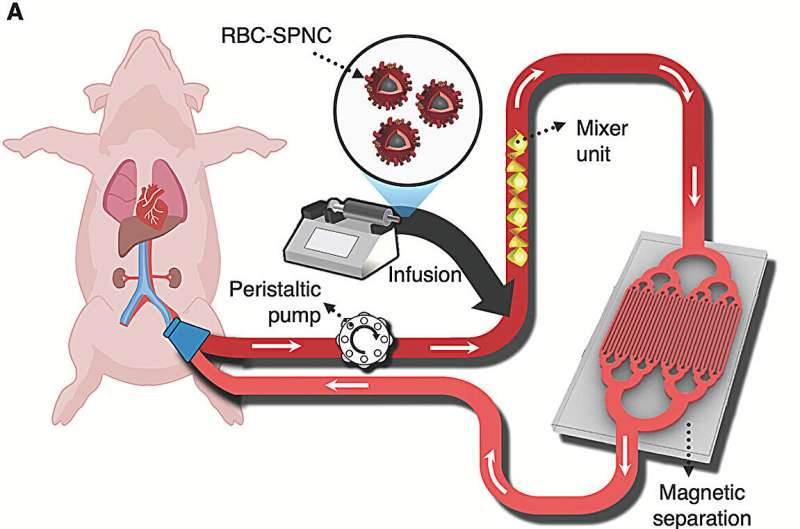May 27, 2024
Editors’ notes
This article has been reviewed according to Science X’s
editorial process
and policies.
Editors have highlighted
the following attributes while ensuring the content’s credibility:
fact-checked
peer-reviewed publication
trusted source
proofread

A research team has introduced a novel technology capable of removing inflammation-triggering agents in extracorporeal blood. The team, led by Professors Joo Hun Kang and Jinmyoung Joo in the Department of Biomedical Engineering at UNIST, in collaboration with Professor Jae Hyuk Lee from Seoul National University Bundang Hospital, anticipates that this innovation will open avenues for sepsis treatment by demonstrating excellent therapeutic effects under conditions similar to those of actual patients.
In their study, published in Small Methods, the team presented a clinically applicable magnetic extracorporeal blood cleansing device utilizing magnetic nanoparticles (MNPs) enveloped by nanovesicles derived from red blood cells (RBC-MNVs).
Utilizing superparamagnetic nanoclusters (SPNCs), the new method is capable of rapidly and effectively removing pathogenic and pathogen-related substances that cause sepsis. Their findings from preclinical experiments also validated the clinical utility of their SPNC-based blood cleansing method by treating lethally infected bacteremic model swine that have similar physiological features to humans.
“Our study highlights the significant reduction in pathogenic agents in both the blood and major organs, as well as amelioration of hemodynamic and hematological parameters, followed by the preservation and restoration of major organ functions,” noted Professor Kang.
“Furthermore, it was possible to effectively remove a broad range of pathogens and inflammatory agents in the blood and major organs without prior diagnosis, leading to a breakthrough treatment effect.”
Sepsis is a systemic abnormal inflammatory response to infection, which causes the immune system to attack tissues and leads to inflammation and potential organ damage. However, there are currently no effective pharmacological treatments for sepsis until now.
In a previous study conducted in 2022, Professor Kang and his research team developed a similar technology using scavenger MNPs enveloped by nanovesicles derived from blood cells (MNVs), which magnetically eradicate an extreme range of pathogens in an extracorporeal circuit.
However, the technology developed in the earlier study had technical limitations in clinical practice, making it challenging to purify several liters of extracorporeal blood due to a low magnetization rate. The technology also showed technical limitations in actual clinical practice. It was difficult to cleanse several liters of extracorporeal blood samples due to low magnetic susceptibility, a force attracted by an external magnetic field.
The team conducted theoretical calculations to determine the size and distribution of MNPs necessary to purify the blood of adult patients within an hour and identified optimal values. By developing a new hydrothermal synthesis method, they were able to synthesize SPNCs with an improved magnetization rate and particle uniformity.
They further validated the clinical utility of their SPNC-based blood cleansing method by treating lethally infected bacteremic model swine. It has also been confirmed that their extracorporeal device can promptly capture and magnetically separate a wide range of pathogens at high blood flow rates (>6 L h−1) in a swine sepsis model.
“The newly developed technology for synthesizing superparamagnetic nanoparticles will also offer advantages in safety evaluations by minimizing side effects, ensuring no magnetic nanoparticles remain in the patient’s blood,” said first author Sung Jin Park, researcher Suhyun Kim, and In Won Park.
“We plan to certify and implement medical devices so that this technology can be used in the medical field,” Professor Kang said. “By developing a new concept of infectious disease treatment technology that can be used as a health security strategy to respond to new and mutated infectious disease outbreaks, we aim to remove various types of pathogens without prior diagnosis.”
More information:
Sung Jin Park et al, Extracorporeal Blood Treatment Using Functional Magnetic Nanoclusters Mitigates Organ Dysfunction of Sepsis in Swine, Small Methods (2024). DOI: 10.1002/smtd.202301428
Provided by
Ulsan National Institute of Science and Technology
Citation:
Study reveals promising technology for sepsis treatment using functional magnetic nanoclusters (2024, May 27)
retrieved 27 May 2024
from https://phys.org/news/2024-05-reveals-technology-sepsis-treatment-functional.html
This document is subject to copyright. Apart from any fair dealing for the purpose of private study or research, no
part may be reproduced without the written permission. The content is provided for information purposes only.
Explore further
New device can treat injury from sepsis
0 shares
Feedback to editors
